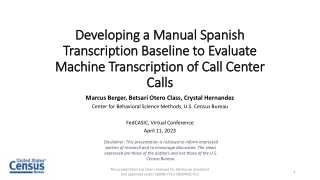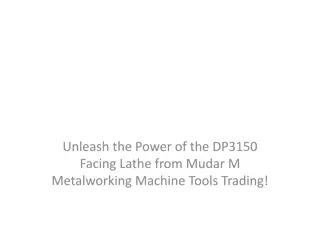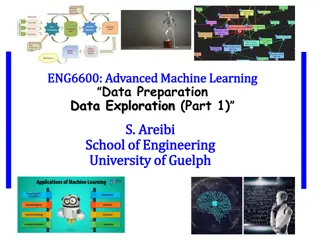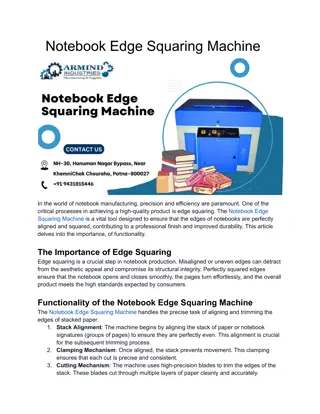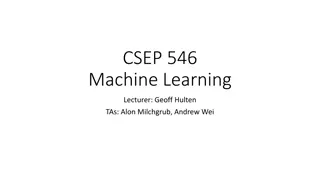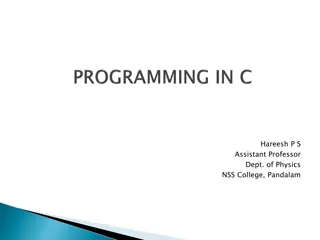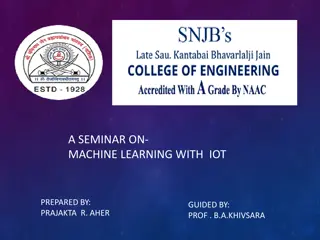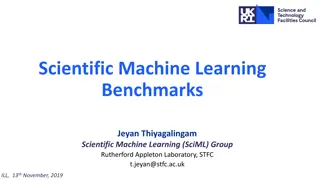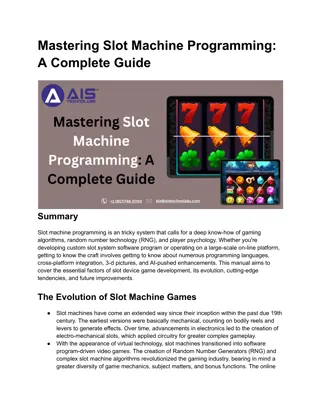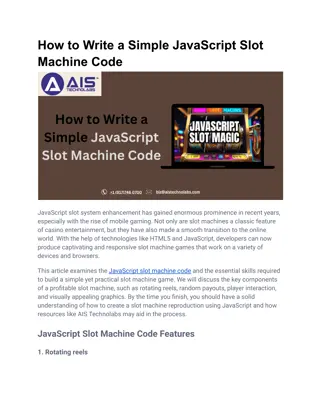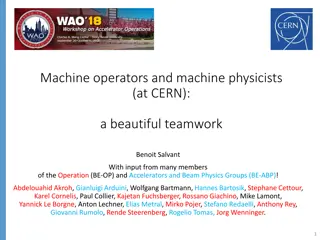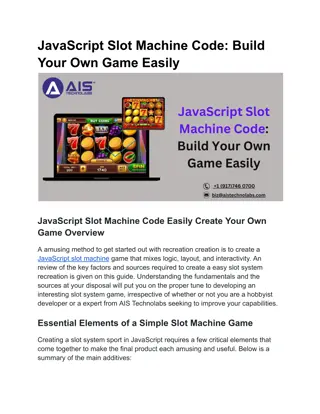
Carnegie Mellon Machine-Level Programming Concepts
Explore the fundamentals of machine-level programming at Carnegie Mellon University, covering topics like Intel processors, assembly basics, and levels of abstraction. Learn about architectures, machine code, assembly code, and more in this comprehensive guide based on the book "Computer Systems: A Programmer's Perspective, Third Edition" by Bryant and O'Hallaron.
Download Presentation

Please find below an Image/Link to download the presentation.
The content on the website is provided AS IS for your information and personal use only. It may not be sold, licensed, or shared on other websites without obtaining consent from the author. If you encounter any issues during the download, it is possible that the publisher has removed the file from their server.
You are allowed to download the files provided on this website for personal or commercial use, subject to the condition that they are used lawfully. All files are the property of their respective owners.
The content on the website is provided AS IS for your information and personal use only. It may not be sold, licensed, or shared on other websites without obtaining consent from the author.
E N D
Presentation Transcript
Carnegie Mellon 14-513 18 18- -613 613 Bryant and O Hallaron, Computer Systems: A Programmer s Perspective, Third Edition
Carnegie Mellon Machine-Level Programming I: Basics 14-513/18-613: Introduction to Computer Systems 5th Lecture, May 27, 2020 2 Bryant and O Hallaron, Computer Systems: A Programmer s Perspective, Third Edition
Carnegie Mellon Today: Machine Programming I: Basics History of Intel processors and architectures Assembly Basics: Registers, operands, move Arithmetic & logical operations C, assembly, machine code 3 Bryant and O Hallaron, Computer Systems: A Programmer s Perspective, Third Edition
Carnegie Mellon Levels of Abstraction #include <stdio.h> int main(){ int i, n = 10, t1 = 0, t2 = 1, nxt; for (i = 1; i <= n; ++i){ printf("%d, ", t1); nxt = t1 + t2; t1 = t2; t2 = nxt; } return 0; } C programmer Nice clean layers, but beware Assembly programmer Computer Designer Gates, clocks, circuit layout, 4 Bryant and O Hallaron, Computer Systems: A Programmer s Perspective, Third Edition
Carnegie Mellon Definitions Architecture: (also ISA: instruction set architecture) The parts of a processor design that one needs to understand for writing correct machine/assembly code Examples: instruction set specification, registers Machine Code: The byte-level programs that a processor executes Assembly Code: A text representation of machine code Microarchitecture: Implementation of the architecture Examples: cache sizes and core frequency Example ISAs: Intel: x86, IA32, Itanium, x86-64 ARM: Used in almost all mobile phones RISC V: New open-source ISA 5 Bryant and O Hallaron, Computer Systems: A Programmer s Perspective, Third Edition
Carnegie Mellon Assembly/Machine Code View CPU Memory Addresses Registers Code Data Stack Data PC Condition Codes Instructions Programmer-Visible State PC: Program counter Memory Byte addressable array Address of next instruction Code and user data Called RIP (x86-64) Register file Stack to support procedures Heavily used program data Condition codes Store status information about most recent arithmetic or logical operation Used for conditional branching 6 Bryant and O Hallaron, Computer Systems: A Programmer s Perspective, Third Edition
Carnegie Mellon Assembly Characteristics: Data Types Integer data of 1, 2, 4, or 8 bytes Data values Addresses (untyped pointers) Floating point data of 4, 8, or 10 bytes (SIMD vector data types of 8, 16, 32 or 64 bytes) Code: Byte sequences encoding series of instructions No aggregate types such as arrays or structures Just contiguously allocated bytes in memory 7 Bryant and O Hallaron, Computer Systems: A Programmer s Perspective, Third Edition
Carnegie Mellon x86-64 Integer Registers %rax %r8 %eax %r8d %rbx %r9 %ebx %r9d %rcx %r10 %ecx %r10d %rdx %r11 %edx %r11d %rsi %r12 %esi %r12d %rdi %r13 %edi %r13d %rsp %r14 %esp %r14d %rbp %r15 %ebp %r15d Can reference low-order 4 bytes (also low-order 1 & 2 bytes) Not part of memory (or cache) 8 Bryant and O Hallaron, Computer Systems: A Programmer s Perspective, Third Edition
Carnegie Mellon Assembly Characteristics: Operations Transfer data between memory and register Load data from memory into register Store register data into memory Perform arithmetic function on register or memory data Transfer control Unconditional jumps to/from procedures Conditional branches Indirect branches 9 Bryant and O Hallaron, Computer Systems: A Programmer s Perspective, Third Edition
Carnegie Mellon Memory Addressing Modes Most General Form D(Rb,Ri,S) D: Constant displacement 1, 2, or 4 bytes Rb: Base register: Any of 16 integer registers Ri: Index register: Any, except for %rsp S: Scale: 1, 2, 4, or 8 (why these numbers?) Mem[Reg[Rb]+S*Reg[Ri]+ D] Special Cases (Rb,Ri) D(Rb,Ri) (Rb,Ri,S) Mem[Reg[Rb]+Reg[Ri]] Mem[Reg[Rb]+Reg[Ri]+D] Mem[Reg[Rb]+S*Reg[Ri]] 10 Bryant and O Hallaron, Computer Systems: A Programmer s Perspective, Third Edition
Carnegie Mellon Address Computation Examples %rdx 0xf000 %rcx 0x0100 Expression Expression Address Computation Address Computation Address Address 0x8(%rdx) 0x8(%rdx) 0xf000 + 0x8 0xf008 (%rdx,%rcx) (%rdx,%rcx) 0xf000 + 0x100 0xf100 (%rdx,%rcx,4) (%rdx,%rcx,4) 0xf000 + 4*0x100 0xf400 0x80(,%rdx,2) 0x80(,%rdx,2) 2*0xf000 + 0x80 0x1e080 11 Bryant and O Hallaron, Computer Systems: A Programmer s Perspective, Third Edition
Carnegie Mellon Address Computation Examples %rdx 0xf000 %rcx 0x0100 Expression Expression Address Computation Address Computation Address Address 0x8(%rdx) 0x8(%rdx) 0xf000 + 0x8 0xf008 (%rdx,%rcx) (%rdx,%rcx) 0xf000 + 0x100 0xf100 (%rdx,%rcx,4) (%rdx,%rcx,4) 0xf000 + 4*0x100 0xf400 0x80(,%rdx,2) 0x80(,%rdx,2) 2*0xf000 + 0x80 0x1e080 12 Bryant and O Hallaron, Computer Systems: A Programmer s Perspective, Third Edition
Carnegie Mellon Moving Data %rax %rcx %rdx %rbx %rsi %rdi %rsp %rbp Moving Data movqSource, Dest Operand Types Immediate: Constant integer data Example: $0x400, $-533 Like C constant, but prefixed with $ Encoded with 1, 2, or 4 bytes Register: One of 16 integer registers Example: %rax, %r13 But %rsp reserved for special use %rN Others have special uses for particular instructions Memory: 8 consecutive bytes of memory at address given by register Simplest example: (%rax) Warning: Intel docs use mov Dest, Source Various other addressing modes 13 Bryant and O Hallaron, Computer Systems: A Programmer s Perspective, Third Edition
Carnegie Mellon movq Operand Combinations Source Dest Src,Dest C Analog movq $0x4,%rax temp = 0x4; Reg Imm movq $-147,(%rax) *p = -147; Mem movq %rax,%rdx temp2 = temp1; Reg Mem movq Reg movq %rax,(%rdx) *p = temp; movq (%rax),%rdx temp = *p; Mem Reg Cannot do memory-memory transfer with a single instruction 14 Bryant and O Hallaron, Computer Systems: A Programmer s Perspective, Third Edition
Carnegie Mellon Understanding Swap() Memory Registers void swap (long *xp, long *yp) { long t0 = *xp; long t1 = *yp; *xp = t1; *yp = t0; } %rdi %rsi %rax %rdx Register %rdi %rsi %rax %rdx Value xp yp t0 t1 swap: movq (%rdi), %rax # t0 = *xp movq (%rsi), %rdx # t1 = *yp movq %rdx, (%rdi) # *xp = t1 movq %rax, (%rsi) # *yp = t0 ret 15 Bryant and O Hallaron, Computer Systems: A Programmer s Perspective, Third Edition
Carnegie Mellon Understanding Swap() Memory Registers Address 0x120 123 %rdi 0x120 0x118 %rsi 0x100 0x110 %rax 0x108 %rdx 456 0x100 swap: movq (%rdi), %rax # t0 = *xp movq (%rsi), %rdx # t1 = *yp movq %rdx, (%rdi) # *xp = t1 movq %rax, (%rsi) # *yp = t0 ret 16 Bryant and O Hallaron, Computer Systems: A Programmer s Perspective, Third Edition
Carnegie Mellon Understanding Swap() Memory Registers Address 0x120 123 %rdi 0x120 0x118 %rsi 0x100 0x110 %rax 123 0x108 %rdx 456 0x100 swap: movq (%rdi), %rax # t0 = *xp movq (%rsi), %rdx # t1 = *yp movq %rdx, (%rdi) # *xp = t1 movq %rax, (%rsi) # *yp = t0 ret 17 Bryant and O Hallaron, Computer Systems: A Programmer s Perspective, Third Edition
Carnegie Mellon Understanding Swap() Memory Registers Address 0x120 123 %rdi 0x120 0x118 %rsi 0x100 0x110 %rax 123 0x108 %rdx 456 456 0x100 swap: movq (%rdi), %rax # t0 = *xp movq (%rsi), %rdx # t1 = *yp movq %rdx, (%rdi) # *xp = t1 movq %rax, (%rsi) # *yp = t0 ret 18 Bryant and O Hallaron, Computer Systems: A Programmer s Perspective, Third Edition
Carnegie Mellon Understanding Swap() Memory Registers Address 0x120 456 %rdi 0x120 0x118 %rsi 0x100 0x110 %rax 123 0x108 %rdx 456 456 0x100 swap: movq (%rdi), %rax # t0 = *xp movq (%rsi), %rdx # t1 = *yp movq %rdx, (%rdi) # *xp = t1 movq %rax, (%rsi) # *yp = t0 ret 19 Bryant and O Hallaron, Computer Systems: A Programmer s Perspective, Third Edition
Carnegie Mellon Understanding Swap() Memory Registers Address 0x120 456 %rdi 0x120 0x118 %rsi 0x100 0x110 %rax 123 0x108 %rdx 456 123 0x100 swap: movq (%rdi), %rax # t0 = *xp movq (%rsi), %rdx # t1 = *yp movq %rdx, (%rdi) # *xp = t1 movq %rax, (%rsi) # *yp = t0 ret 20 Bryant and O Hallaron, Computer Systems: A Programmer s Perspective, Third Edition
Carnegie Mellon Today: Machine Programming I: Basics History of Intel processors and architectures Assembly Basics: Registers, operands, move Arithmetic & logical operations C, assembly, machine code 21 Bryant and O Hallaron, Computer Systems: A Programmer s Perspective, Third Edition
Carnegie Mellon Address Computation Instruction leaqSrc Src is address mode expression Set Dst to address denoted by expression Src, Dst Dst Uses Computing addresses without a memory reference E.g., translation of p = &x[i]; Computing arithmetic expressions of the form x + k*y k = 1, 2, 4, or 8 Example long m12(long x) { return x*12; } Converted to ASM by compiler: leaq (%rdi,%rdi,2), %rax # t = x+2*x salq $2, %rax # return t<<2 22 Bryant and O Hallaron, Computer Systems: A Programmer s Perspective, Third Edition
Carnegie Mellon Some Arithmetic Operations Two Operand Instructions: Format Computation addq Src,Dest subq Src,Dest imulq Src,Dest shlq Src,Dest sarq Src,Dest shrq Src,Dest xorq Src,Dest andq Src,Dest orq Src,Dest Dest = Dest + Src Dest = Dest Src Dest = Dest * Src Dest = Dest << Src Dest = Dest >> Src Dest = Dest >> Src Dest = Dest ^ Src Dest = Dest & Src Dest = Dest | Src Synonym: salq Arithmetic Logical Watch out for argument order! Src,Dest (Warning: Intel docs use op Dest,Src ) No distinction between signed and unsigned int (why?) 23 Bryant and O Hallaron, Computer Systems: A Programmer s Perspective, Third Edition
Carnegie Mellon Some Arithmetic Operations One Operand Instructions incq Dest decq Dest negq Dest notq Dest Dest = Dest + 1 Dest = Dest 1 Dest = Dest Dest = ~Dest See book for more instructions Depending how you count, there are 2,034 total x86 instructions (If you count all addr modes, op widths, flags, it s actually 3,683) 24 Bryant and O Hallaron, Computer Systems: A Programmer s Perspective, Third Edition
Carnegie Mellon Arithmetic Expression Example arith: leaq (%rdi,%rsi), %rax addq %rdx, %rax leaq (%rsi,%rsi,2), %rdx salq $4, %rdx leaq 4(%rdi,%rdx), %rcx imulq %rcx, %rax ret long arith (long x, long y, long z) { long t1 = x+y; long t2 = z+t1; long t3 = x+4; long t4 = y * 48; long t5 = t3 + t4; long rval = t2 * t5; return rval; } Interesting Instructions leaq: address computation salq: shift imulq: multiplication Curious: only used once 25 Bryant and O Hallaron, Computer Systems: A Programmer s Perspective, Third Edition
Carnegie Mellon Understanding Arithmetic Expression Example arith: leaq (%rdi,%rsi), %rax # t1 addq %rdx, %rax # t2 leaq (%rsi,%rsi,2), %rdx salq $4, %rdx # t4 leaq 4(%rdi,%rdx), %rcx # t5 imulq %rcx, %rax # rval ret long arith (long x, long y, long z) { long t1 = x+y; long t2 = z+t1; long t3 = x+4; long t4 = y * 48; long t5 = t3 + t4; long rval = t2 * t5; return rval; } Register Use(s) %rdi Argument x %rsi Argument y %rdx Argument z, t4 t1, t2, rval %rax %rcx t5 26 Bryant and O Hallaron, Computer Systems: A Programmer s Perspective, Third Edition
Carnegie Mellon Today: Machine Programming I: Basics History of Intel processors and architectures Assembly Basics: Registers, operands, move Arithmetic & logical operations C, assembly, machine code 27 Bryant and O Hallaron, Computer Systems: A Programmer s Perspective, Third Edition
Carnegie Mellon Turning C into Object Code Code in files p1.c p2.c Compile with command: gcc Og p1.c p2.c -o p Use basic optimizations (-Og) [New to recent versions of GCC] Put resulting binary in file p text C program (p1.c p2.c) Compiler (gcc Og -S) Asm program (p1.s p2.s) text Assembler (gcc or as) binary Object program (p1.o p2.o) Static libraries (.a) Linker (gcc or ld) binary Executable program (p) 28 Bryant and O Hallaron, Computer Systems: A Programmer s Perspective, Third Edition
Carnegie Mellon Compiling Into Assembly C Code (sum.c) long plus(long x, long y); Generated x86-64 Assembly sumstore: pushq %rbx movq %rdx, %rbx call plus movq %rax, (%rbx) popq %rbx ret void sumstore(long x, long y, long *dest) { long t = plus(x, y); *dest = t; } Obtain (on shark machine) with command gcc Og S sum.c Produces file sum.s Warning: Will get very different results on non-Shark machines (Andrew Linux, Mac OS-X, ) due to different versions of gcc and different compiler settings. 29 Bryant and O Hallaron, Computer Systems: A Programmer s Perspective, Third Edition
Carnegie Mellon What it really looks like Things that look weird and are preceded by a . are generally directives. .globl sumstore .type sumstore, @function sumstore: .LFB35: .cfi_startproc pushq %rbx .cfi_def_cfa_offset 16 .cfi_offset 3, -16 movq %rdx, %rbx call plus movq %rax, (%rbx) popq %rbx .cfi_def_cfa_offset 8 ret .cfi_endproc .LFE35: .size sumstore, .-sumstore sumstore: pushq %rbx movq %rdx, %rbx call plus movq %rax, (%rbx) popq %rbx ret 30 Bryant and O Hallaron, Computer Systems: A Programmer s Perspective, Third Edition
Carnegie Mellon Assembly Characteristics: Data Types Integer data of 1, 2, 4, or 8 bytes Data values Addresses (untyped pointers) Floating point data of 4, 8, or 10 bytes (SIMD vector data types of 8, 16, 32 or 64 bytes) Code: Byte sequences encoding series of instructions No aggregate types such as arrays or structures Just contiguously allocated bytes in memory 31 Bryant and O Hallaron, Computer Systems: A Programmer s Perspective, Third Edition
Carnegie Mellon Assembly Characteristics: Operations Transfer data between memory and register Load data from memory into register Store register data into memory Perform arithmetic function on register or memory data Transfer control Unconditional jumps to/from procedures Conditional branches 32 Bryant and O Hallaron, Computer Systems: A Programmer s Perspective, Third Edition
Carnegie Mellon Object Code Code for sumstore Assembler Translates .s into .o Binary encoding of each instruction Nearly-complete image of executable code Missing linkages between code in different files 0x0400595: 0x53 0x48 0x89 0xd3 0xe8 0xf2 0xff 0xff 0xff 0x48 0x89 0x03 0x5b 0xc3 Linker Resolves references between files Combines with static run-time libraries E.g., code for malloc, printf Some libraries are dynamically linked Total of 14 bytes Each instruction 1, 3, or 5 bytes Starts at address 0x0400595 Linking occurs when program begins execution 33 Bryant and O Hallaron, Computer Systems: A Programmer s Perspective, Third Edition
Carnegie Mellon Machine Instruction Example C Code Store value t where designated by dest *dest = t; Assembly Move 8-byte value to memory movq %rax, (%rbx) Quad words in x86-64 parlance Operands: t: Register %rax dest: Register %rbx *dest: Memory M[%rbx] Object Code 3-byte instruction Stored at address 0x40059e 0x40059e: 48 89 03 34 Bryant and O Hallaron, Computer Systems: A Programmer s Perspective, Third Edition
Carnegie Mellon Disassembling Object Code Disassembled 0000000000400595 <sumstore>: 400595: 53 push %rbx 400596: 48 89 d3 mov %rdx,%rbx 400599: e8 f2 ff ff ff callq 400590 <plus> 40059e: 48 89 03 mov %rax,(%rbx) 4005a1: 5b pop %rbx 4005a2: c3 retq Disassembler objdump d sum Useful tool for examining object code Analyzes bit pattern of series of instructions Produces approximate rendition of assembly code Can be run on either a.out (complete executable) or .o file 35 Bryant and O Hallaron, Computer Systems: A Programmer s Perspective, Third Edition
Carnegie Mellon Alternate Disassembly Disassembled Dump of assembler code for function sumstore: 0x0000000000400595 <+0>: push %rbx 0x0000000000400596 <+1>: mov %rdx,%rbx 0x0000000000400599 <+4>: callq 0x400590 <plus> 0x000000000040059e <+9>: mov %rax,(%rbx) 0x00000000004005a1 <+12>:pop %rbx 0x00000000004005a2 <+13>:retq Within gdb Debugger Disassemble procedure gdb sum disassemble sumstore 36 Bryant and O Hallaron, Computer Systems: A Programmer s Perspective, Third Edition
Carnegie Mellon Alternate Disassembly Disassembled Object Code Dump of assembler code for function sumstore: 0x0000000000400595 <+0>: push %rbx 0x0000000000400596 <+1>: mov %rdx,%rbx 0x0000000000400599 <+4>: callq 0x400590 <plus> 0x000000000040059e <+9>: mov %rax,(%rbx) 0x00000000004005a1 <+12>:pop %rbx 0x00000000004005a2 <+13>:retq 0x0400595: 0x53 0x48 0x89 0xd3 0xe8 0xf2 0xff 0xff 0xff 0x48 0x89 0x03 0x5b 0xc3 Within gdb Debugger Disassemble procedure gdb sum disassemble sumstore Examine the 14 bytes starting at sumstore x/14xb sumstore 37 Bryant and O Hallaron, Computer Systems: A Programmer s Perspective, Third Edition
Carnegie Mellon Machine Programming I: Summary History of Intel processors and architectures Evolutionary design leads to many quirks and artifacts C, assembly, machine code New forms of visible state: program counter, registers, ... Compiler must transform statements, expressions, procedures into low-level instruction sequences Assembly Basics: Registers, operands, move The x86-64 move instructions cover wide range of data movement forms Arithmetic C compiler will figure out different instruction combinations to carry out computation 38 Bryant and O Hallaron, Computer Systems: A Programmer s Perspective, Third Edition

